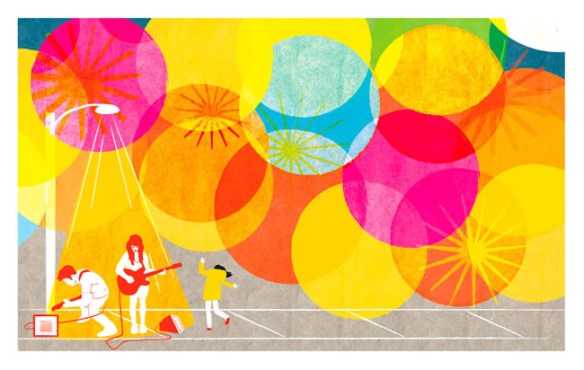I bought Symphony City–by illustrator, graphic designer and self-proclaimed “indie rock obsessive” Amy Martin–because it is beautiful.
Unfortunately, one sentence makes for a very short post, so I’ve spent several days considering this book, working out what more there is to say. And it’s this: I love Symphony City as a work of art. As a work of story, not so much.
Symphony City‘s narrative–about a little girl lost in the city–feels incidental, a way to tie the images together. In fact, the type is so slight it nearly blends into the page, secondary to the art. I almost wonder whether the book could have been wordless, allowing readers to find their own story.
I sat with this book on a Sunday morning while listening to an NPR program about music. Trombone Shorty was being interviewed, and he talked about the street sounds of New Orleans. (As a young boy, Shorty–born Troy Evans–played trombone in the Treme neighborhood, and now, at the ripe age of 25, is a crowned prince of jazz, hip-hop and funk.) It was the perfect context in which to think about Symphony City. It got me thinking about rhythm.
I don’t think people consider rhythm in writing enough. Sometimes it’s hard to identify when not accompanied by rhyme. For me, it’s that thing that makes the written word just feel right when read out loud. It can also be a pattern that repeats. It’s often tied up in voice and tone, and all of those things we learned in Composition 101. And it can truly make or break a children’s book.
Because it is a book about music, I want Symphony City to have rhythm. And once it gets going, it does:
and fills the sky
it pours in waves
through open windows
and expands
it starts as a sprout
and bursts into a forest
The pattern is repeated: The music is small, then grand, then finally altogether quiet. Which is, of course, sometimes the way symphonies work. And sometimes the way cities work too.
Martin’s illustrations have rhythm as well. When the little girl is bored at home, her world is a cardboard gray. But the world outside is full of color. Even she–in her yellow jacket–is part of the music.
The visual rhythm falls apart somewhere in the middle of the book when the pages start to feel more like individual spreads than part of a whole. At this point, the art becomes more about design, color and mood than supporting the story.
 In fact, one spread stands out so much, I wonder whether it was the jumping off point for the whole book. Night has fallen, the sky is dark, but suddenly there’s a riot of color as the girl dances to the music of an electric guitar. Blazing pinks, oranges and yellows fill the sky, nearly blotting out the moon and cold of the spread before. (This image has also been turned into a poster on the inside of the dust jacket, and the circle motif is repeated on the endpapers.) It is clear that of all the music she has heard today, this is the little girl’s favorite.
In fact, one spread stands out so much, I wonder whether it was the jumping off point for the whole book. Night has fallen, the sky is dark, but suddenly there’s a riot of color as the girl dances to the music of an electric guitar. Blazing pinks, oranges and yellows fill the sky, nearly blotting out the moon and cold of the spread before. (This image has also been turned into a poster on the inside of the dust jacket, and the circle motif is repeated on the endpapers.) It is clear that of all the music she has heard today, this is the little girl’s favorite. As I said, this book is a work of art. A lush, evocative, thoughtful work of art, right down to the use of pulpy brown paper and the golden birds on the cover. It is not a book I will read and read again, but I will most certainly revisit the pictures.
As I said, this book is a work of art. A lush, evocative, thoughtful work of art, right down to the use of pulpy brown paper and the golden birds on the cover. It is not a book I will read and read again, but I will most certainly revisit the pictures.
Images from Symphony City written and illustrated by Amy Martin, © 2011. Published by McSweeney’s McMullens.
